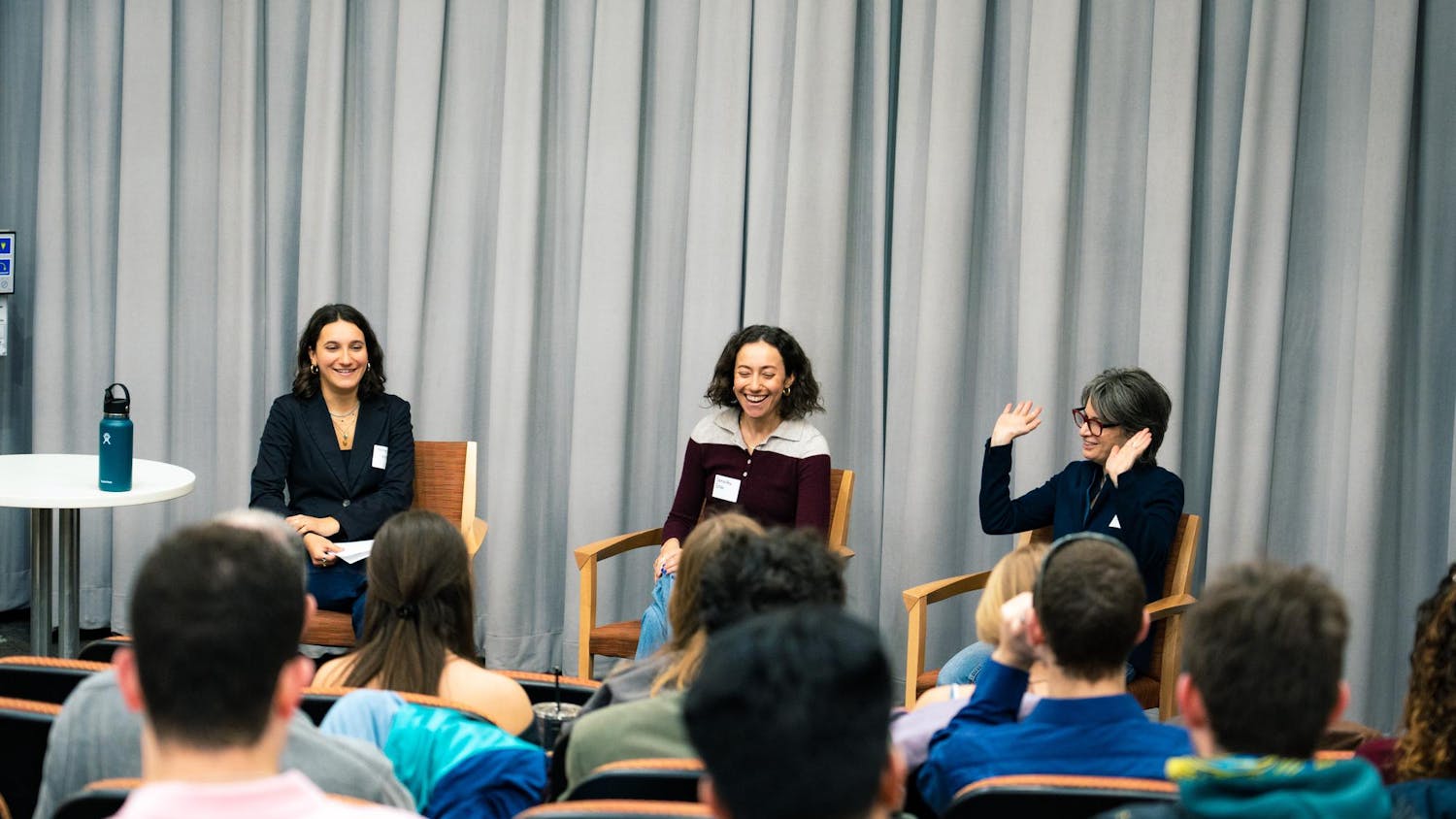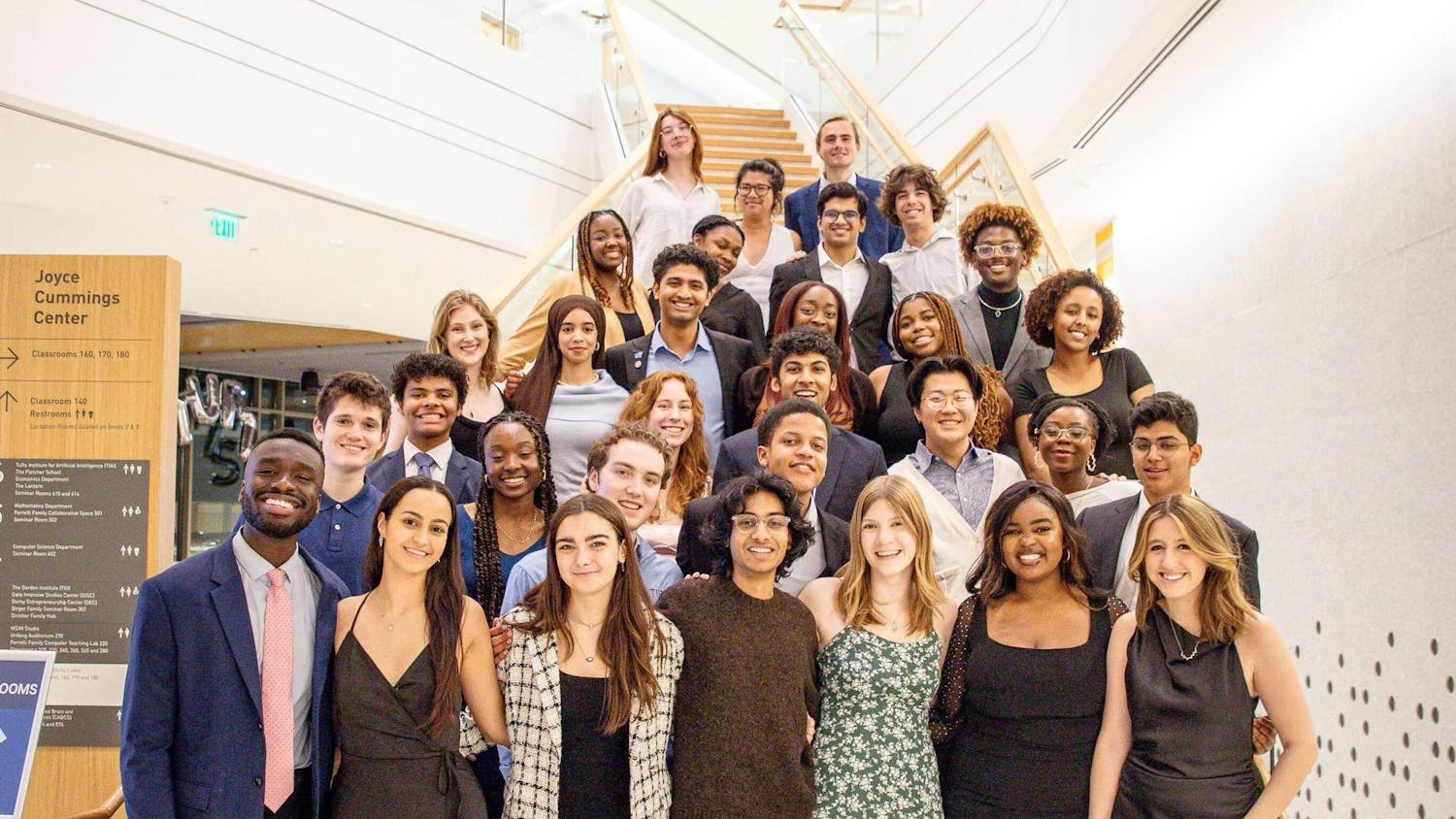The admissions process for prospective students at any university is chock full of flattering statistics, gratifying rankings and self?proclaimed assets. At Tufts, the undergraduate student body of 5,194 students ?? about 16 percent of whom are international ?? and a student to faculty ratio of nine to one may be among the most sought?after facts by prospective students and their parents. Yet when push comes to shove, the Office of Admissions ?? through its' employees, representatives and student surrogates ?? has one job: to sell Tufts. And that means looking past the statistics and numbers.
When Admissions Officer Justin Pike addresses high school students, his primary goal is to be helpful.
"Many seniors in high school meet with a parade of college reps that focus on facts and figures which tend to blur together," Pike said. "What are the students like? Why is it actually cool to be smart here? What makes a Tufts student interesting to talk to? If I can shed light on those questions, I see a lot of eyes light up for Tufts."
When Larry Bacow stepped in as president 11 years ago, Tufts branded itself as a good school that was medium?sized and near, but not in, a city.
"It wasn't an identity," Associate Director of Admissions Daniel Grayson said. Grayson, a Tufts alumnus himself, reflected on his experience from the other side.
"When I arrived [as a student] in 2002, the admissions office had virtually no message," he said. "When I did my campus tour and [information] session, I can honestly say those things made no impact on me whatsoever when I was choosing my college."
As Tufts began to search for its identity, Bacow and Admissions did not attempt to create one from scratch, instead looking to articulate what was already here, according to Grayson.
To distinguish itself from other top institutions in the Boston area and beyond, Admissions must sell a personality and environment unique to Tufts. They accomplish this by selling the personalities of the admissions officers themselves.
"I go into school visits and try the best I can to represent Tufts as a place that is smart and interesting by being myself smart and interesting, with surprisingly little hard detail about the school," Grayson said. "The goal is to simulate meeting a bunch of Tufts students [and to] do that myself."
First?year students recalled the application process and fond memories of their interaction with Tufts' representatives.
"When [the admissions officer] answered questions, he talked about the a cappella groups and the weird traditions like the cannon, making it seem more like a place to be than just an academic institution," freshman Annie Kolle said. "He was really funny and definitely on the weird side, in a good way. Very quirky, enthusiastic and fun."
An interdisciplinary approach is the cornerstone of Tufts' academic environment, and Admissions looks to draw upon this important characteristic to differentiate itself.
Freshman Seth Gray described Grayson's memorable visit to his high school last fall. Grayson provided a list of undergraduate majors and asked students to pick any two from the list.
"I picked geology and history, and he proceeded to show me how I could study both at the same time," Gray said. This strategy not only revealed the diversity of classes and academic opportunities offered at Tufts, but engaged students in an interactive way.
"I don't really remember facts, but it's the one college talk I remember," Gray said.
As an engineering student, senior tour guide John Gill noted this interdisciplinary approach as a major reason for choosing Tufts himself. He emphasizes this point on his tours by talking about the Experimental College.
"You're not coming here just to be an engineer," Gill said. "You're taking classes all over the board, and the ExCollege is a really great way to do that."
Diversity is a second point Admissions looks to promote, but not in the traditional sense of the word.
"The main thing about Tufts is [that] at my high school everyone wanted to be the same, but here everyone wants to be different," Gray said.
When Gray visited Tufts as a prospective freshman, a Shakespeare flash mob broke out in Dewick?MacPhie Dining Center while he was eating lunch.
"People were reenacting the balcony scene of 'Romeo and Juliet,'" he recalled. "At first I assumed everyone was going to start laughing and stare, but when I realized everyone was just watching, I was like, 'this is awesome.'"
Sophomore tour guide Abbie Cohen emphasized the importance of a student body with a unique and fun collection of interests.
"I always stress how many various opportunities Tufts has, because I know that each one will connect with a different student on my tour in a different way," Cohen said.
Tufts may have an ethnically diverse student body, but Admissions is working to promote the intellectual diversity that more appropriately represents what makes the Tufts community unique, Grayson said.
"As much as possible, I try to describe diversity [not as] a set of identifiers ?? things you can check off on a census form ?? but to describe the reason it's important, [which] is intellectual diversity," Grayson said.
Qualities such as race and socioeconomic status can influence an individual's worldview, but they aren't the only factors that matter, according to Grayson.
The Office of Undergraduate Admissions, in its search to embody the Tufts community, looks for ways to be distinctive. One way they have achieved this in the past is through the introduction of a new supplement to the application two years ago, which gave prospective students the opportunity to post a YouTube video as part of their application.
"[The YouTube supplement] hasn't changed anything about the way we do admissions or what we look for, but I think having it there represents something important to high school students and their counselors ?? that there are a lot of different ways to demonstrate your sense of self and your identity," Grayson said. "I think that there are a surprisingly few number of schools that enjoy a reputation nationwide for being places where who you are matters in the admission process, and we're one of them."
With this new identity to project outward, Admissions faced a new set of challenges. Buzzwords such as "globalism" and "diversity" tend to be associated with Tufts and reflective of the campus community, but they carry meanings outside of Tufts that differ from what they were initially intended to portray on campus.
One example is active citizenship, which has come to mean community service to those off?campus, but was originally used at Tufts to describe how students use their intellect and passions and frame them in such a way that the world benefits, Grayson explained.
"The identity of Tufts in high schools is IR [international relations] dominant, not because Tufts is IR dominant, but because globalism has come to carry that meaning," Grayson said. "We would talk about globalism and be describing the type of globalism that exists in the School of Engineering, but what people would hear is IR."
Gill, though, feels that this trend is changing.
"Admissions has definitely made a switch between the old focus of purely international to something more of the unique Tufts experience and trying to define that for high school students," he said.
Grayson cited early evidence of this change, saying that Admissions has seen a new diversity of interests among the students applying early decision over the last several years.
"The ED pool used to be really IR and political science?centered, and we've started to see an increase in majors that are really good here but don't fall under the social science [and] Fletcher umbrella," Grayson said.
A more recent way Admissions is currently working to project the Tufts name and image is through a program called "Who Gets In and Why." The program presents a case study of six Tufts applicants, simulating the kind of conversations that take place in an application committee process.
By attracting students and high school guidance counselors, Admissions hopes to extend Tufts' reach and attract students in areas from which they have previously not received many applications ?? perhaps due to a lack of awareness for what Tufts stands for.
"I think that moment where adults around you say, 'Oh, what is Tufts?' is a huge intellectual and emotional barrier in a decision people are making," Grayson said.
Admissions is looking to erase whatever stigma may exist in regards to applying to Tufts by reaching out to guidance counselors with programs like "Who Gets In and Why."
"It's a presentation that's completely changing the way we get traction and visibility in cities, states and countries where the Tufts name is not as well known as it should be," he said.
Ultimately, the student community is the biggest selling point for admissions officers, but selling prospective Jumbos on what Grayson calls the "vibe" of Tufts can be a tricky business.
"Vibe matters, but you can't talk about vibe to talk about vibe," Grayson said. "That's immediately inauthentic."
"I can address their fears, connect them to students back on campus and bring with me whatever of that campus 'vibe' I can," Pike said.
Admissions officers may accurately imitate a great campus "vibe," but the decision to apply ultimately rests with the applicants themselves.
"It's almost scary how little time a prospective student has to judge a school, and conveying enthusiasm for your school is so huge in recruiting students," Gill said. "Every new tour guide sits there practicing with their flashcards knowing the admissions percentages. At this point, I've forgotten every fact they've ever told me."
Gill explained that when parents ask about the student?faculty ratio, it's much more meaningful to respond with a story about a freshman year English course or a really great Experimental College class experience than to lay out cold, hard facts.
"Especially as you get older and have more and more stories to share," he said, "that's what your tour becomes."





